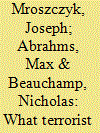| Srl | Item |
| 1 |
ID:
166666


|
|
|
|
|
| Summary/Abstract |
Those who study terrorism are familiar with the claim that suicide attacks are the most lethal form of terrorism today. Suicide attacks kill more people on average than non-suicide attacks, thereby justifying why terrorist organizations use this costly method of attack and explaining in part why suicide tactics have proliferated. However, extant empirical support for this claim is largely insufficient, focusing only on macro-level analysis of lethality data. Using data from the Global Terrorism Database, this study examines variation in lethality among suicide and non-suicide attacks based on geographic location, attack type, and target/victim type. It also introduces a new metric—the lethality ratio—to measure costs and benefits of attacks in terms of lives lost. It finds that, although suicide tactics are generally more lethal than non-suicide tactics, they also come at greater costs to the organization. This analysis also finds behavior that is inconsistent with the premise that terrorist groups are focused on maximizing lethality while reducing costs in all cases; that despite certain advantages, suicide attacks may remain a suboptimal tactic from the perspective of the terrorist group; and that additional criteria may help explain why suicide tactics are used.
|
|
|
|
|
|
|
|
|
|
|
|
|
|
|
|
| 2 |
ID:
156616


|
|
|
|
|
| Summary/Abstract |
In recent years, a growing body of empirical research suggests that indiscriminate violence against civilian targets tends to carry substantial political risks compared to more selective violence against military targets. To better understand why terrorist groups sometimes attack politically suboptimal targets, scholars are increasingly adopting a principal-agent framework where the leaders of terrorist groups are understood as principals and lower level members as agents. According to this framework, terrorist leaders are thought to behave as essentially rational political actors, whereas lower level members are believed to harbor stronger non-political incentives for harming civilians, often in defiance of leadership preferences. We test this proposition with an original content analysis of terrorist propaganda videos. Consistent with the principal–agent framework, our analysis demonstrates statistically that terrorist leaders tend to favor significantly less indiscriminate violence than their operatives actually commit, providing unprecedented insight into the incentive structure of terrorist leaders relative to the rank-and-file.
|
|
|
|
|
|
|
|
|
|
|
|
|
|
|
|